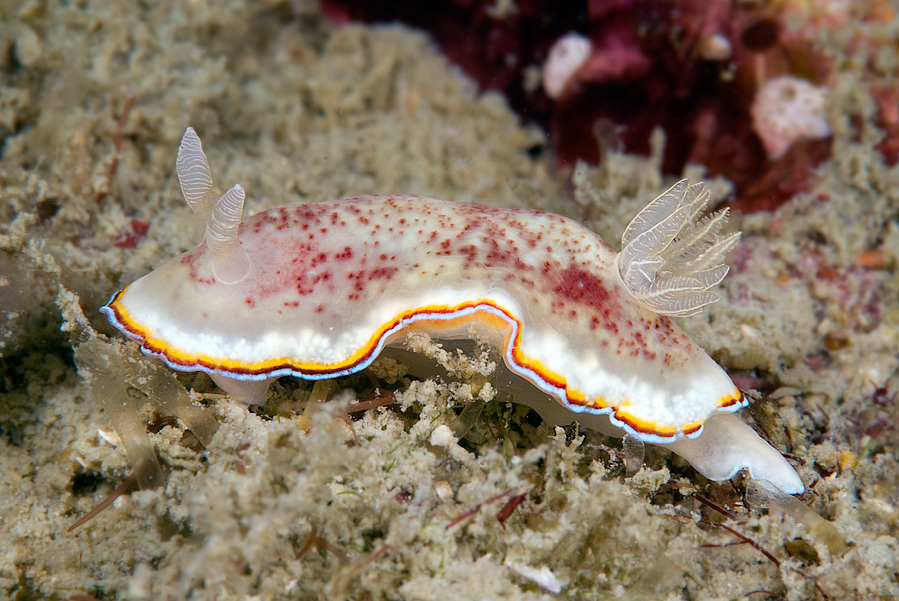 |
Chromodoris trimarginata
Photo was taken at a depth of around 8 metres at Koh Talu (Talu Island) which lies within the Hat Nopparat Thara-Mu Koh Phi Phi National Park in Krabi Province of western ThailandPhoto courtesy of Lawrence Neal
Copyright 2010
Chromodoris trimarginata (Winckworth, 1946)
Chromodoris trimarginata (Bill Rudman's Sea Slug Forum ) is reasonably common in shallow sandy, rocky or rubble environments of the Andaman Sea, usually in coastal waters. However, the species seems to be restricted in range to the Eastern Indian Ocean, from India across to Myanmar, Thailand and the west coast of Malaysia. As its name suggests, the species has a three-colour mantle margin made up of an outer white or pale blue band, followed by red and then an inner orange band, with all three bands of similar width. The species also has a characteristic band of densely packed opaque white mantle glands, clearly visible through the translucent white mantle. Chromodoris trimarginata gets up to about 30 mm in size. This species is quite similar in appearance to Chromodoris preciosa , which is present in the same environments and across the same geographical range, and has a similar tri-marginal band. They can be differentiated by the gills and rhinophores, which are translucent white with opaque white edging in Chromodoris trimarginata but translucent red with white edging in Chromodoris preciosa .References:
• Rudman, W.B. (1985) The Chromodorididae (Opisthobranchia: Mollusca) of the Indo-West Pacific: Chromodoris aureomarginata, C. verrieri and C. fidelis colour groups. Zoological Journal of the Linnean Society, 83: 241-299.
• Valdes, A., Mollo, E. & Ortea, J. (1999) Two new species of Chromodoris (Mollusca, Nudibranchia, Chromodorididae) from southern India, with a redescription of Chromodoris trimarginata (Winckworth, 1946). Proceedings of the California Academy of Sciences, 51(13): 461-472.
Bangkok, Thailand
Aug., 2010
WEBMASTER'S NOTES: Truly great nudibranch shots can often tell a story beyond the sheer beauty of the animal! Lawrence's image above is one such image. Note the predominant mantle glands skirting the fringe of
the subject. While the active secretion of defensive chemicals has personally been seen in several species of Glossodoris , the same has never been seen (at least by the Webmaster) in species of Chromodoris . This question was addressed to Dr. Valdes who indicated he too has never seen a Chromdoris secrete in the highly visable manner of some Glossodoris and added that as a
general rule(but by no means hard and fast) "... Chromodoris are highly variable in the morphology of their mantle glands, but mostly have only one row, whereas Glossodoris have more than one!.." So as the reader can
tell, the plot is certainly grown murkier as to what we are dealing with here(Chromodoris vs. Glossodoris)! But don't despair, there is ongoing research up at the California Academy of Sciences that will certainly shed additional light on this group (Chromodoris ) in the near future. So stay tuned folks!
San Diego, CA
Aug., 2010
Lawrence at Tulamben, Bali, Indonesia with
Agung Volcano in background

Lawrence is a newspaper journalist based in Bangkok, Thailand. He escapes the office as often as he can to go diving in the rich waters of the Indo-Pacific but his regular dive sites are just down the road at Pattaya in the Gulf of Thailand or at Khao Lak on the Andaman coast. Lawrence uses a Nikon D200 in a Nexus housing with a pair of Inon Z240s. The photo at top was taken using a 105 mm macro lens.
Send Lawrence mail at lorenzo_n@yahoo.com |
